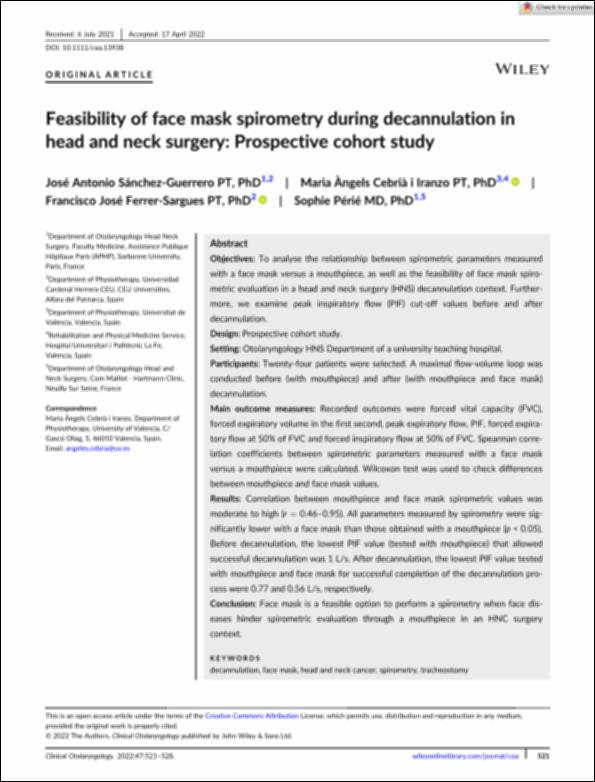Por favor, use este identificador para citar o enlazar este ítem:
http://hdl.handle.net/10637/14384Feasibility of face mask spirometry during decannulation in head and neck surgery prospective cohort study
| Título : | Feasibility of face mask spirometry during decannulation in head and neck surgery prospective cohort study |
| Autor : | Sánchez Guerrero, José Antonio Cebrià i Iranzo, Maria Àngels Ferrer Sargues, Francisco José Périé, Sophie |
| Materias: | Traqueotomía.; Face - Surgery.; Cuello - Cirugía.; Tracheotomy.; Spirometry.; Espirometría.; Cara - Cirugía.; Neck - Surgery. |
| Editorial : | John Wiley & Sons |
| Citación : | Sánchez-Guerrero, J. A., Cebrià I Iranzo, M. À., Ferrer-Sargues, F. J. & Périé, S. (2022). Feasibility of face mask spirometry during decannulation in head and neck surgery: prospective cohort study. Clinical Otolaryngology, vol. 47, i. 4 (jul.), pp. 521–528. DOI: https://doi.org/10.1111/coa.13938 |
| Resumen : | Objectives: To analyse the relationship between spirometric parameters measured with a face mask versus a mouthpiece, as well as the feasibility of face mask spirometric evaluation in a head and neck surgery (HNS) decannulation context. Furthermore, we examine peak inspiratory flow (PIF) cut-off values before and after decannulation. Design: Prospective cohort study. Setting: Otolaryngology HNS Department of a university teaching hospital. Participants: Twenty-four patients were selected. A maximal flow-volume loop was conducted before (with mouthpiece) and after (with mouthpiece and face mask) decannulation. Main outcome measures: Recorded outcomes were forced vital capacity (FVC), forced expiratory volume in the first second, peak expiratory flow, PIF, forced expiratory flow at 50% of FVC and forced inspiratory flow at 50% of FVC. Spearman correlation coefficients between spirometric parameters measured with a face mask versus a mouthpiece were calculated. Wilcoxon test was used to check differences between mouthpiece and face mask values. Results: Correlation between mouthpiece and face mask spirometric values was moderate to high (r = 0.46–0.95). All parameters measured by spirometry were significantly lower with a face mask than those obtained with a mouthpiece (p < 0.05). Before decannulation, the lowest PIF value (tested with mouthpiece) that allowed successful decannulation was 1 L/s. After decannulation, the lowest PIF value tested with mouthpiece and face mask for successful completion of the decannulation process were 0.77 and 0.56 L/s, respectively. Conclusion: Face mask is a feasible option to perform a spirometry when face diseases hinder spirometric evaluation through a mouthpiece in an HNC surgery context. |
| Descripción : | Este artículo se encuentra disponible en la siguiente URL: https://onlinelibrary.wiley.com/doi/epdf/10.1111/coa.13938 |
| URI : | http://hdl.handle.net/10637/14384 |
| Derechos: | http://creativecommons.org/licenses/by/4.0/deed.es |
| ISSN : | 1749-4478 1749-4486 (Electrónico) |
| Idioma: | es |
| Fecha de publicación : | 1-jul-2022 |
| Centro : | Universidad Cardenal Herrera-CEU |
| Aparece en las colecciones: | Dpto. Enfermería y Fisioterapia |
Los ítems de DSpace están protegidos por copyright, con todos los derechos reservados, a menos que se indique lo contrario.


